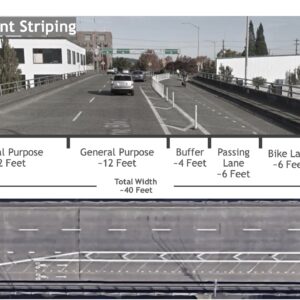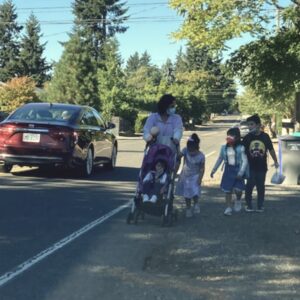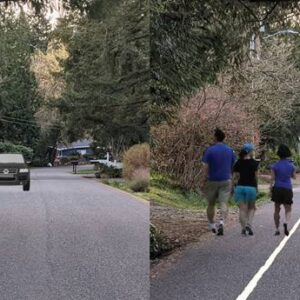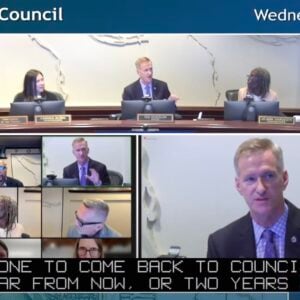
A new law proposal in front the Oregon State Legislature would reduce the speed limit for vehicles on “narrow” streets to 15 mph.
The concept (House Bill 2297) is backed by Milwaukie Democrat Carolyn Tomei and received a hearing on the House floor yesterday.
BTA lobbyist Scott Bricker, PDOT traffic safety expert Greg Raisman, both made the trip south to testify on its behalf.
The proposed concept would define narrow roadways as any road that is:
- Located in a residence district;
- Intended for through vehicular traffic;
- Not of sufficient width to allow one lane of traffic in each direction.
Portland is full of narrow streets like these and this proposal could have a huge impact on making bicycle travel safer. Of course, like existing speed limits, they’re only as good as the enforcement behind them.
The chart below illustrates the life and death consequences of speed:
Stay tuned for updates on this proposal and for opportunities to weigh in with your support.
==========
UPDATE: PDOT is proposing an amendment to this concept that would clarify the definition of “narrow roadway”. They feel the current definition is much too broad, would cover “hundreds of miles” of streets, would cause confusion, and would cost millions to add signage. Here’s the added clarification they want to add (in bold, taken from their official testimony in Salem yesterday):
“Narrow roadway’ means a roadway that is: ….(3) Not of sufficient width to allow one lane of traffic in each direction. Less than 18 feet in width and a contiguous portion of roadway beginning and ending at a crossroad or roadway terminus defined as a dead-end“
The PDOT rep also testified that,
“We feel that this definition meets the intent of the original language and offers a more explicit definition that provides a clear standard for motorists and will allow police to enforce the law without ambiguity with regard to whether a street “is not of sufficient width to allow one lane of traffic in each direction”. In addition, the proposed language provides that a roadway must be less than 18-feet wide for one block or longer in a residential area for the statutory 15 mph provision to apply.”







Thanks for reading.
BikePortland has served this community with independent community journalism since 2005. We rely on subscriptions from readers like you to survive. Your financial support is vital in keeping this valuable resource alive and well.
Please subscribe today to strengthen and expand our work.
This is great and is IMO one of the best ways to make roads safer for cyclists. You could catch 10 cars an hour on my “residential” and “narrow” NE street doing 25+.
We need this so much! 25 MPH is still too much for streets where we expect everyone, from 8 to 80, to feel safe walking and bicycling.
Because my house is located near a major road, I frequently have drivers blasting through (at over 50 mph) in order to beat traffic. I would fully support any speed limit changes.
In the meantime, does anyone know how to go about having the city install speed bumps? The big ones that make vehicles bottom out and tear off oil pans? I would rather clean up oil than blood.
I like this proposal and support most any effective reduction of speeding on residential streets.
But I’d like to point out that these kinds of “narrow” streets – streets that are “not of sufficient width to allow one lane of traffic in each direction” – are already naturally slowed by the gauntlet of parked cars (assuming there are cars parked on both sides). Cars travelling in opposite directions must slow, stop, and do a little dance in order to pass one another. This is GREAT for slowing traffic, raising awareness, and making these streets safer for children, pedestrians and bicyclists. Formally reducing the speed limit will complement this existing engineering solution to residential street safety.
The reduced speed limit will also help address speeding on streets that aren’t engineered for low speeds in this way. Many residential streets are very wide and smooth, and free of parked cars because all of the houses have driveways. But whatever the posted speed limit says, if you can comfortably drive 30 or even 40 mph on these streets, people will. And faster.
So in addition to reduced speed limits, I’d like to see the ENGINEERING limit of streets reduced, i.e. the speeds the street will accomodate before all but the craziest of drivers feel out of control.
Residential neighborhoods built with wide, flat highways for streets are contriving after-the-fact ways to make those streets feel more like SE 28th between Belmont and Stark – see this example:
http://www.trafficcalming.org/
Reduced speed limits, if complemented by enforcement of those limits, are great. But let’s remind ourselves to build streets for safety from the start!
For more about engineering for low speeds and safety, check out the work of Hans Monderman.
http://en.wikipedia.org/wiki/Hans_Monderman
Mike,
Speed bumps are fairly expensive, and normally the neighborhood must contribute some of the funds. There are other ways to slow traffic, too, that might be more effective.
That’s all I know. Anyone else?
Michelle
I think this is a great proposal, but we’ll need an exception to allow bikes to go faster than the 15 mph speed limit. OK, I’m kidding, but some cyclists will be “speeding “on some of these streets. I can imagine the message threads here after all-vehicle speed enforcement catches cyclists in the net…
Mike (comment 3),
The photo I took above was on N. Michigan where we have the exact problem you describe…people cut through to avoid rush hour on I-5.
The guy that painted on the street has had enough…but he can’t get his neighbors to pony up for speed bumps.
Other routes include getting in touch with PDOT to have a speed reader board installed and/or share the road signs put on your lawn.
contact Sharon White.
sharon.white[at]pdxtrans.org
Enforcement of 15 mph? Are you joking? Running red lights, stop signs, and speeding in full view of police is most often already ignored.
One PDOT person told me this was because there are only about 7 actual traffic cops in the entire city!
Here is a proposal: Equip citizen volunteers with speed radar guns and cameras. Let us nab the b@$t@rds and submit the evidence for citations, or at least formal warnings that go on the driver’s record.
Michelle, Mike,
Here’s the official info on speed bumps.
http://www.portlandonline.com/transportation/index.cfm?c=eafca
Bill
Mark (#6)
All kidding aside, 15 MPH will be 15MPH for everyone and the police will issue citations to cyclists. The judges will have no mercy in the courtroom either since we will be given “equal treatment”. If this passes, I pity the poor rider who passes or appears visually faster than a car radar gunned doing 15 MPH.
I live on Mississippi a bit north of where that pic was taken and we get the same I-5 sidesteppers. My neighbors don’t want to pony up either. I’ve taken to parking my old car a good couple of feet from the curb, directly across from my cross-street neighbors, creating a bit of a pinch point.
Sooner or later one of the kids on this street will get nicked and I reckon the pocketbooks will open at that point.
I also tried to buy stop sticks once, but the guy on the phone kept asking me what agency I with…
I live on Mississippi a bit north of where that pic was taken and we get the same I-5 sidesteppers. My neighbors don’t want to pony up either. I’ve taken to parking my old car a good couple of feet from the curb, directly across from my cross-street neighbors, creating a bit of a pinch point.
Sooner or later one of the kids on this street will get nicked and I reckon the pocketbooks will open at that point.
I also tried to buy stop sticks once, but the guy on the phone kept asking me what agency I with…
I’m with Michael. This is the most useless piece of proposed legislation I’ve heard of in a long time. If car drivers routinely ignore the speed limits why will lowering the limits make any difference? Sheesh, why don’t we just legislate everyone must be polite and nice to each other.
It is about enforcement, or lack thereof. Ambulance chasing trial lawyers have made a mint for themselves suing small businesses that hadn’t complied with the ADA (American with Disabilities Act). They were able to exploit this facet of the law because they lobbied to include a provision that private citizens could sue on behalf of the disabled and recoup their litigation costs if they won. There are similar laws which allow whistle-blowers to collect a portion of the money the Fed’s recoup when gov defrauders are found and convicted, typically it’s been with Medicare.
So, it is not without precedence or reason, that the most effective way to deal with speeding and similar traffic violations is to allow citizens to cite drivers on behalf of the government *and* collect part of the bounty. Interstingly, this is the same deal given to the red-light photo radar companies. So, why do they get all the play?
Note, private citizens can cite traffic violators on behalf of the government, but they get no compensation for the considerable effort required. As a result actual instances of private citizens doing this have been entirely limited to injured cyclists needing a traffic conviction in order to be taken seriously by the violator’s insurance company.
Want to slow cars down in your n’hood? PDOT also has a new “Share the Road” sign program.
Check out this article to learn more.
“Of course, like existing speed limits, they’re only as good as the enforcement behind them.”
Imagine the moaning here when a speed enforcement effort tabs cyclists as well as cars. Generally it seems most people here are against traffic law enforcement, at least where bikes are concerned.
I don’t really see how this law helps cyclists. A car cannot pass a bike on a street that’s only wide enough to accommodate one vehicle, I feel safer on these streets than I do in a bike lane on a road like Barbur. None of the fatalities in Portland, either this year or in 2005 (there were no fatalities in 2006) were on small, one lane city roads, and as you said last month: “The discrepancy between fatalities within the city limits vs. outlying areas supports my feeling that the biggest safety threat facing cyclists are rural roads.”
I can see this as a pedestrian issue, especially in neighborhoods where children are likely to be running around, but I just can’t see how lowering the speed limit by 5-10 miles an hour on these streets will affect cyclists.
Any time cars are going slower, it helps cyclists because the driver will have more time to react before running into the cyclist. Make sense?
I just updated the post to reflect the official testimony of PDOT. They want to amend the current proposal with a clearer definition of “narrow roadway.”
If you are interested in learning how to slow down traffic without the need for expensive concrete engineering, I highly recommend: http://www.lesstraffic.com/Articles/Traffic/SRdesign.htm
And if you find these ideas compelling, and you’d like to help neighborhoods accomplish some of this stuff, please get in touch with me! I’ve had an idea brewing for more than a year now.
“Any time cars are going slower, it helps cyclists” Yes, it’s self-evident.
What is not self-evident is that lowering the unposted speed limits will cause any cars to actually go slower.
A few years back, the city had a program where they’d park a trailer with a “your speed is…” readout. I think it also had a photo radar ticketing system, but I could be wrong. Neighbors could request it be parked on certain streets, and it would sit there for a few days or a week. Only streets where the speed limit was under 30 were eligible, but it seemed like a good enforcement tool. Anyone know what happened to it?
Representative Tomei thank you for helping us out. And Scott and Greg thanks for supporting this.
Good work, as much of our urban speed limits and 85th%ile traffic speeds are basically a death sentence for any elderly or child pedestrian struck by a driver operating a motorized vehicle.
My preference, as transportation planner, would be a more nuanced law incorporating the Swedish ‘New Approach’ so that all streets would have a more logical rational for setting urban speeds, but I know that our leaders and engineering community are still too focused on promoting speed and traffic volume over safety and protecting drivers.
I would suggest adding:
– allowing this speed limit to residental streets without sidewalks (perhaps ADA ramps too)
– unpaved streets
– some language to the effect that drivers driving faster than speed limit take 100% of resposibility for fault.
How about some modifications to this bill to make it politically feasible statewide:
– combine it with higher rural speed limits?
If you visit the website I posted above, (post 18) I’d recommend downloading the free PDF entitled “Intrigue & Uncertainty Towards New Traffic-Taming Tools”
The author talks about how we lost our streets in the first place, and goes on to propose many strategies that neighborhoods can use to get them back.
From the author…
“Imagine a time when children played in our streets and adults met there to chat.
The presence of children and adults in the roadway created a high degree of intrigue
and uncertainty so motorists traveled very slowly. But some motorists pushed the
safety boundaries and drove too fast. Some parents became intimidated and
instructed their children to play on the sidewalk. Moving the children (and other adult
activities) out of the street reduced both the intrigue and uncertainty factors. So
motorist felt it was now safe to go faster. This made it feel unsafe to play or hold
conversations on the sidewalk, so these activities were moved to the front yard or
local park. Intrigue and uncertainty further declined, so the traffic went even faster. As
speeds increased, residents retreated even further by not walking, not allowing their
children to walk, and not parking their car in the street.
Each step of this psychological retreat from the street not only eroded the quality
of neighborhood life and sense of community — it also encouraged the traffic to go
even faster by diminishing the intrigue and uncertainty factors”
Martha, At yesterday’s “traffic safety rally” someone proposed having one of those
speed read-out trailers parked a block ahead of where we are set up so that drivers take note of their speed before they see us holding signs telling them to slow down. If you get any info on how to make use of one of those things, can you pass it along? Thanks
This will be meaningless without enforcement, and I doubt the city will put the resources towards such enforcement.
I take exception to the idea that drivers only respect the sight of a police cruiser as a disincentive to speed. I think drivers, like cyclists, peds, and transit riders, come in a wide spectrum from polite-and-considerate to reckless-to-the-point-of-homicidal.
Those drivers on the reckless end of the spectrum will doubtless pay little heed to a new limit. Those on the considerate side of the spectrum will slow.
So effectively we’re talking about reducing speeds of a certain percentage of drivers (I believe large percentage, at least as compared to other urban areas), and increasing the opportunity to ticket the rest.
The police are constrained by a certain amount of “measurement slop” – they can’t count on convicting a driver who goes 30 in a 25 mph zone, as judges routinely allow for a certain amount of speedometer error.
Take a look at the chart – the difference between getting hit by a car going 20 and a car going 30 is the difference between 5% fatality rate and 45% fatality rate. In other words, if you could slow the drivers down by 10 mph, you drop the chance of fatality by a factor of 9.
What’s not to like about this law? It’s not perfect, but it sure as H*** gives enforcement officers a better chance of stopping and convicting speeders. And it sends the message to everyone that speeding is bad.
I’d like to see the PoPo focus more on speeding enforcement on these neighborhood streets, and less on the freeways and expressways. The only time I’ve ever received a ticket for speeding within Portland’s city limits, it was on 99e, just south of the Ross Island Bridge.
Not exactly a street with pedestrians, bicyclists, or a reputation for safety issues…
I believe the cop was just out to see how many tickets he could write.
So, I think that a certain amount of reform needs to also happen within the police bureau, to get them to focus more on preventing bike/ped injuries and fatalities, and less on just writing the most volume of tickets possible.
Of course, when I got this ticket, the PoPo still had a white supremacist from L.A. at the helm…
I think it is about time for a speed limit reduction on neighborhood streets. I live on a quiet narrow street with no curbs or sidewalks in SW PDX. We have our share of people flying through our neighborhood at speeds in excess of 25mph. It scares me to send the kids across the street to play at times.
I would like to see them add two things to the legislation. First, a reduction to 15mph in cases of limited sight distance over a crest of hill like we do in SW PDX. There are a number of streets where you cannot see oncoming traffic until you crest the hill.
Second, reduce the speed in instances where sight distances are reduced by heavy vegetation. Large trees, shrubs, vines, etc can drastically reduce your ability to see other traffic entering the roadway or around corners.
Martha 20, Jacque 23,
Info on the reader boards can be had at:
http://www.portlandonline.com/shared/cfm/image.cfm?id=139638
It’s a PDF.
Bill
Mike (comment 3),
Another option, that cyclists are well aware of, is you can call the Dept of Transportation (I think the # is 503-823-SAFE) and ask for a traffic safety enforcement action. I’ve tried this route 2 times, the first time the police came at the wrong time (1-2 PM instead of rush hour) to counter my complaint of excessive speeding. I’m still waiting for a response from my second call.
Maybe regular 50 mph drivers on a residential street will get the cops up in arms as much as a few cyclists running stop signs?
I would suggest punishing all drivers for the sins of speeders–eliminate car theft enforcement and follow up, and divert all those officers and funding to speeding enforcement. When speeding enforcement is no longer needed, then the cops can spend the time going after car thieves.
I like the site Jacque mentioned. How difficult would it be to get this created?
— Universal Anchoring Device. This is a device embedded in the roadway or sidewalk which allows a wide variety of street reclaiming devices to be quickly attached or changed (banner poles, sculptures, etc.) The city can control where the devices are located. Maximum sizes that can be attached are stamped on the anchoring device. Either the city or residents can create devices that plug into the Universal Anchoring Device.
Over and over it has been made clear that we’ve continuously expanded city resources to deal with roads and traffic. Leaders are FINALLY realizing that we’ve hit the limit. We cannot enforce laws becuase police funds have topped out, we cannot engineer roads becuase DOT’s budgets are topped. It’s now becoming clear that only citizens will be able to create change. Unfortunately the roadway has been labeled sacrosanct by planners. So it’s illegal to put any permanent item in the road besides a car. I would REALLY like to see this changed. We can start by enacting the above paragraph.
Also, speaking of police, how about staffing the speeding enforcement division exclusively with officers who have had a history of excessive force complaints on their records? I believe that getting drivers to truly fear police would be a very, very good thing.
Speaking of street reclaiming, I’ve often thought “roadwitching” would be a form of community traffic calming that could work here in Portland.
http://www.wormworks.com/roadwitch/index.html
ODOT’s proposal to restrict the 15 mph speed limit to streets 18 ft wide pretty much eliminates most neighborhood streets in Portland and so I’m not sure what the real value would be?
PS (to my post above) the street in the picture is much more than 18 ft. wide so would never qualify for the 15 mph rule if ODOT had its choice.
Donna,
The concept behind Road Witching is pretty much one and the same as whats behind “Intrigue & Uncertainty -Towards New Traffic-Taming Tools” You can download the PDF at http://www.lesstraffic.com/Articles/Traffic/SR1.htm
I’ve had a few people contact me about bringing these ideas to the city. Let me know if you’d like to be involved.